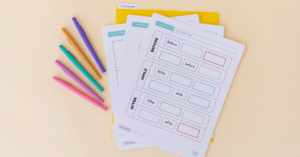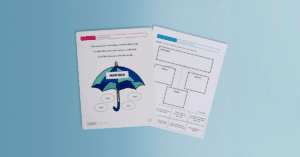You’re working really hard to provide awesome therapy to your students. You prepped those amazing activities. You attended that massive conference to pick up some new strategies. You are working so. darn. hard.
Yet…your staff has no clue. They may or may not know what you are working on with your students, and they likely wouldn’t be able to point out the awesome progress that Johnny is making.
You’re not alone.
I was in the same boat, and I knew that something had to change–especially since what I was targeting in the therapy room wasn’t being noticed in the classroom.
I did a ton of research and came up with some solutions. I have been raving about literacy-based therapy ever since.
The best part is that it makes our jobs easier, and we can also use it to help our students.
Here are the four tips that helped me make the most progress!
1. Pick Literature from the Classroom
“Hey, Mrs. Smith! What are your students reading this week?”
That’s all it takes!
If they can give you the name of a book or an article, you are set! You have a text that you can use for relevant, curriculum-based therapy.
If they can’t give you the name of a particular book, then you can ask what they’re learning about in science, social studies, or language arts. There are so many books out there! There’s bound to be a book that matches one of the themes that is being discussed in the classroom.
2. Explicitly Focus on Skills
This is key! If your students know what their goals are, they will be able to answer questions like…
“What are you doing in speech?”
“What did you learn with Mrs. X today?”
They’ll also be more likely to make connections with the curriculum. “Hey, I’m learning how to summarize in speech/language therapy!”
There are countless ways you could increase goal awareness, but a goal pocket chart is one example of a tool/system that you can use to review goals.
3. Integrate Skills with Parallel Stories
Ukrainetz shares an incredibly helpful framework in her book, Contextualized Language Intervention (affiliate link). The last step of her framework includes a parallel story.
For example, if students just completed a unit using the book Snowmen at Night, then they can write a parallel story about what trees do at night. They can integrate all of the speech and language skills targeted throughout the entire unit to create an exciting final product. Students really take ownership of their final stories and are excited to share their book with parents, teachers, and friends. This is an amazing opportunity to practice all of those skills outside of the therapy room.
Work with middle school or high school students? I also wrote about some alternative activity ideas for older students!
4. Involve the Team
I periodically share updates with teachers and use the Remind app to communicate with parents along the way. This way, when students share their parallel stories, the team is aware of the students’ goals. They’ll be able to see the student use these skills in a meaningful way and will be able to provide opportunities for continued practice.
Want to learn more about literacy-based therapy? We are starting a FREE literacy-based therapy challenge that will include free planning templates, materials, inspiration, and more! Click here to sign up!





Reader Interactions